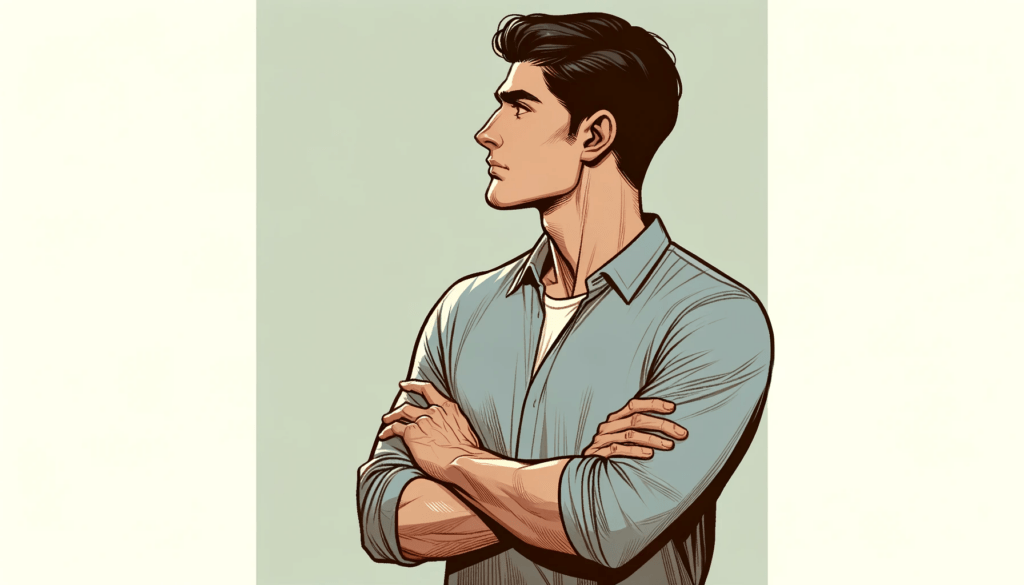Crossed arms — you’ve seen it in meetings, at social gatherings, maybe even caught yourself doing it. It’s a common gesture, one that almost everyone uses at some point.
But have you ever stopped to think about what it really means? This simple act of folding our arms across our chest can speak volumes about our feelings, thoughts, and even our personality, without us uttering a single word.
The gesture is rarely just a random habit; it’s a form of non-verbal communication deeply rooted in human psychology.
In this article, we’re going to explore the various meanings behind crossed arms. We’ll look at how this gesture can mean different things in different contexts and what it might say about a person’s personality.
Key Takeaways:
- Crossed arms often signal defensiveness or resistance, indicating a person may feel threatened or uncomfortable.
- In some contexts, crossed arms can reflect self-comforting or a way to maintain personal space.
- Observing accompanying facial expressions and posture is crucial for accurate interpretation of crossed arms.
- Crossed arms can also be a habit or a comfortable resting position for some, devoid of significant emotional meaning.
The Meanings Behind The Crossed Arms Body Language

1. To express disagreement or resistance
You can often spot someone expressing disagreement or resistance through their crossed arms by looking for additional body language cues. For example, they might have a stern or frustrated facial expression.
Their brows may be furrowed, and their eyes could display a certain sharpness, indicating they’re not on board with what’s being discussed.
Another clue lies in their overall posture. Along with crossed arms, they might lean away from the person or subject they disagree with.
It’s like their whole body is saying, “I’m not interested or I don’t agree.” Pay attention to how they position themselves; it can reveal a lot about their feelings.
If the arm crossing happens during a debate or a contentious discussion, it’s more likely a sign of disagreement or resistance.
2. Engaging In Deep Thought Or Critical Analysis
Crossing arms can be a sign that someone is deeply thinking or analyzing a situation. This kind of arm crossing often looks more relaxed and contemplative, rather than rigid or defensive.
The person might also have a focused or introspective facial expression, indicating they’re lost in thought.
Their environment can give you a clue as well. If they’re in a setting that requires concentration, like a meeting, a lecture, or while solving a problem, their crossed arms might be helping them focus.
It’s a posture that can help some people gather their thoughts and ideas more effectively.
Also watch for subtle nods or changes in facial expression as they think.
Even while their arms are crossed, these small movements can indicate that they’re processing information and engaging in critical thinking.
It shows their engagement with the thought process, even if they’re not verbally expressing it.
[Also Read: 5 Body Language Signs Of A Manipulator]
3. Indicating Confidence or Authority
Contrary to popular belief, crossed arms aren’t always a negative signal. In some cases, they can exude a sense of confidence or authority.
Picture a CEO addressing their team, arms crossed, exuding control and assurance. It’s a power stance that can convey leadership and assertiveness.
In social situations, this posture can be a display of self-assurance. When someone is comfortable in their environment, crossing arms might be a relaxed, confident stance rather than a defensive one.
Moreover, in group dynamics, those with crossed arms might be seen as figures of authority or influence.
It’s a non-verbal cue that can subtly indicate someone’s dominant role or status in a group. Isn’t it intriguing how body language can speak volumes about our social positions?
4. Demonstrating A Closed Or Unreceptive Attitude
Recognizing a closed or unreceptive attitude in someone with crossed arms can be quite straightforward.
Their body language tends to be less about comfort and more about creating a barrier.
You might see them physically turning away from others or the conversation, almost as if they’re trying to block out what’s being said.
Their facial expressions can also be telling. Look for signs of disinterest, like a lack of eye contact, an impassive or blank face, or even eye-rolling.
These expressions often accompany a closed attitude, signaling that they’re not open to listening or engaging.
Also, consider their engagement in the conversation. Someone with a closed attitude might be less likely to contribute, speak, or even acknowledge others’ points.
Their lack of verbal participation, coupled with crossed arms, is a strong indicator of an unreceptive mindset.
5. A Sign of Defense or Discomfort
When someone crosses their arms, it’s often seen as a protective shield. This gesture is like a physical barrier we put up, maybe when we’re feeling a bit insecure or on edge.
But it’s not just about creating a barrier. This posture can also hint at emotional discomfort. Picture yourself in a tense meeting.
Crossing your arms might be your body’s way of coping with stress or anxiety. It’s like giving yourself a little hug to comfort and compose yourself.
There’s also the aspect of defensiveness. In heated discussions, crossed arms can signal that someone is not open to what’s being said.
6. Sometimes a Crossed Arm Doesn’t Mean Anything
There are instances where crossed arms might not carry any significant meaning.
It’s essential to remember that body language can be influenced by various factors, including personal habits, comfort, and the surrounding environment.
Not every instance of crossed arms is a window into someone’s soul.
For some people, crossing their arms is just a comfortable resting position. It doesn’t necessarily mean they’re upset, defensive, or closed off.
It could simply be a habit or a preferred way to hold their arms when they’re relaxed.
People often adopt certain postures because they feel naturally comfortable, without any deeper psychological reasoning.
Environmental factors play a role too. In colder settings, people might cross their arms to keep warm. Here, the action is more about physical comfort than emotional expression.
Similarly, in casual social gatherings, people might cross their arms without any particular reason.
It’s always important to consider the context and not jump to conclusions based on a single gesture.
[Interesting: 8 Body Language Signs Of Guilt]
What is The Psychology Behind The Crossed Arm Body Language?

The psychology behind crossed arms dives deep into our non-verbal communication.
This gesture, where arms are folded across the chest, often indicates a mental or emotional barrier.
It’s like a shield, reflecting our instinct to protect ourselves when we feel vulnerable or threatened.
Interestingly, crossing arms can also signal a person’s internal state. It might be a subconscious response to anxiety, discomfort, or a need for self-assurance.
In moments of uncertainty or stress, we might cross our arms without even realizing it, as a way to comfort ourselves.
Moreover, this body language can serve as a silent communicator of our attitudes.
A person with crossed arms during a conversation may be unconsciously showing resistance or skepticism towards what’s being discussed.
It’s amazing how our bodies can express feelings without words, isn’t it?
[Read: 8 Body Language Signs Of A Confident Person]
Crossed Arm Body Language For Men and Women
Crossed arms can mean slightly different things for men and women, influenced by social and cultural factors.
For men, this gesture often denotes assertiveness or a desire to assert dominance in a situation.
It’s a stance that says, “I’m in control here,” and is frequently seen in business or competitive environments.
For women, crossed arms might be more about seeking comfort or shielding oneself from perceived negativity or judgment.
It can be a way of maintaining personal space, especially in unfamiliar or uncomfortable settings.
However, it’s essential to note that these interpretations are not absolute and can vary greatly depending on the person and context.
Both men and women may cross their arms for various reasons, ranging from self-comfort to skepticism, making it a versatile and nuanced aspect of body language.
[Related: What Does Body Language Mean?]
How Can You Interpret Crossed Arms in a Conversation?
Interpreting crossed arms in a conversation requires attention to context and other non-verbal cues.
If someone crosses their arms while you’re speaking, they might be feeling defensive or resistant to the ideas being presented. It’s like their body is saying, “I’m not entirely on board with this.”
However, it’s not always a negative sign. Sometimes, people cross their arms simply because they are comfortable that way, or they might be cold.
It’s crucial to consider the overall body language and the environment to get a clearer picture.
In addition, crossed arms can signal that the person is deeply thinking or processing the information.
Especially in a complex conversation, this gesture might indicate that they are contemplating what’s being discussed, rather than outright rejecting it.
What Does Crossed Arms Say About a Person’s Personality?
Crossed arms might reveal certain traits about a person’s personality. People who frequently adopt this posture could be seen as naturally more guarded or cautious.
They might value personal space and be more introspective or self-reliant.
On the flip side, this gesture can sometimes indicate a tendency towards skepticism or a critical thinking approach.
Such individuals might not accept things at face value and prefer to evaluate information thoroughly before accepting it.


